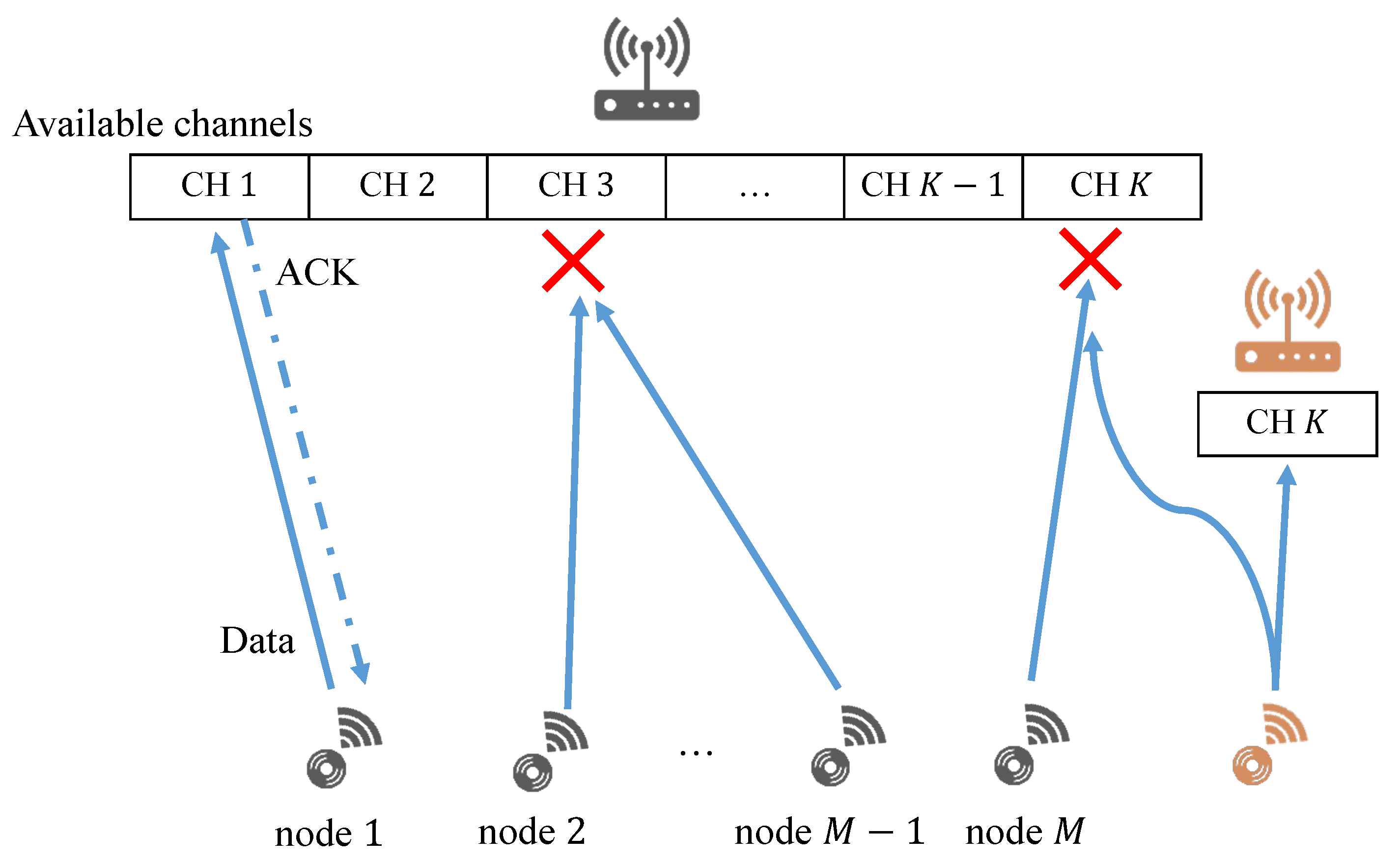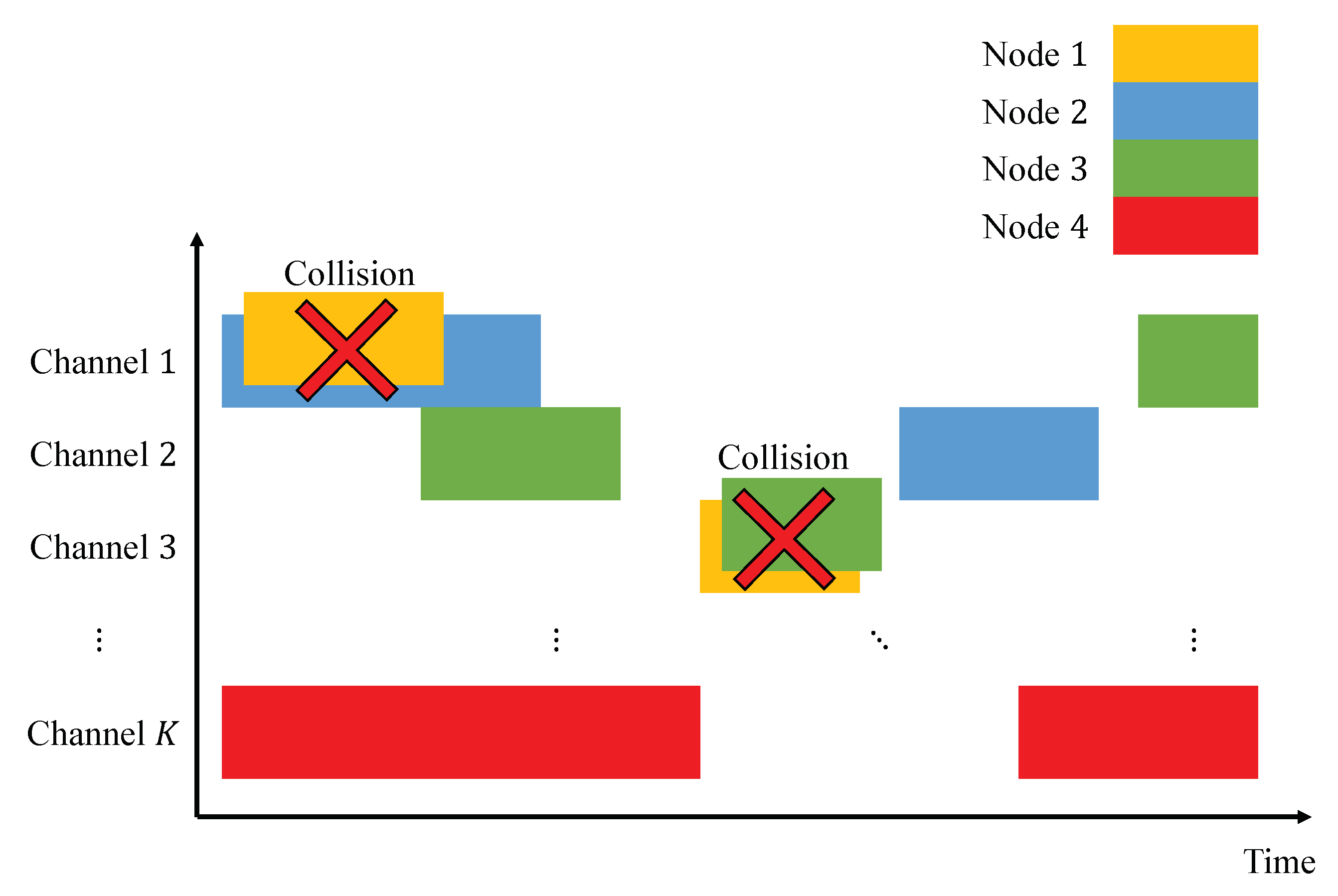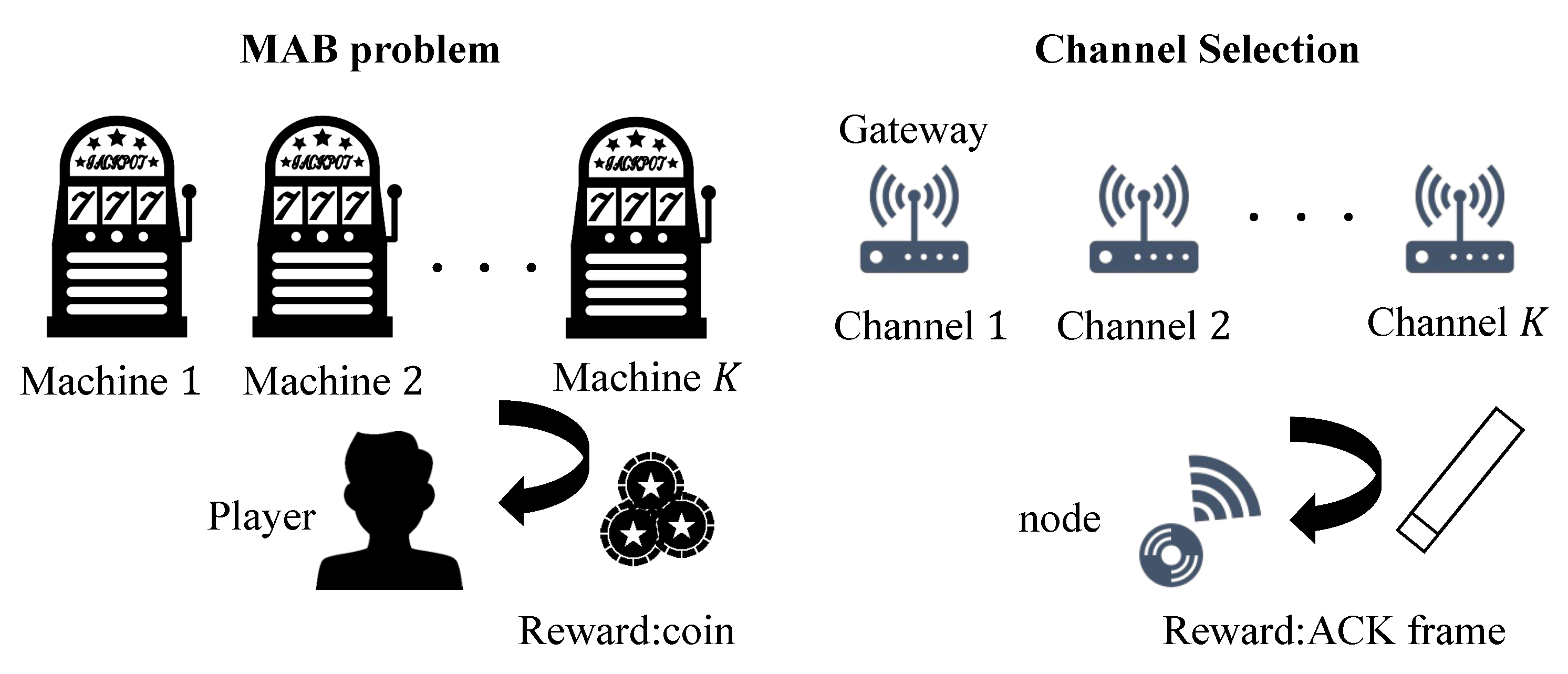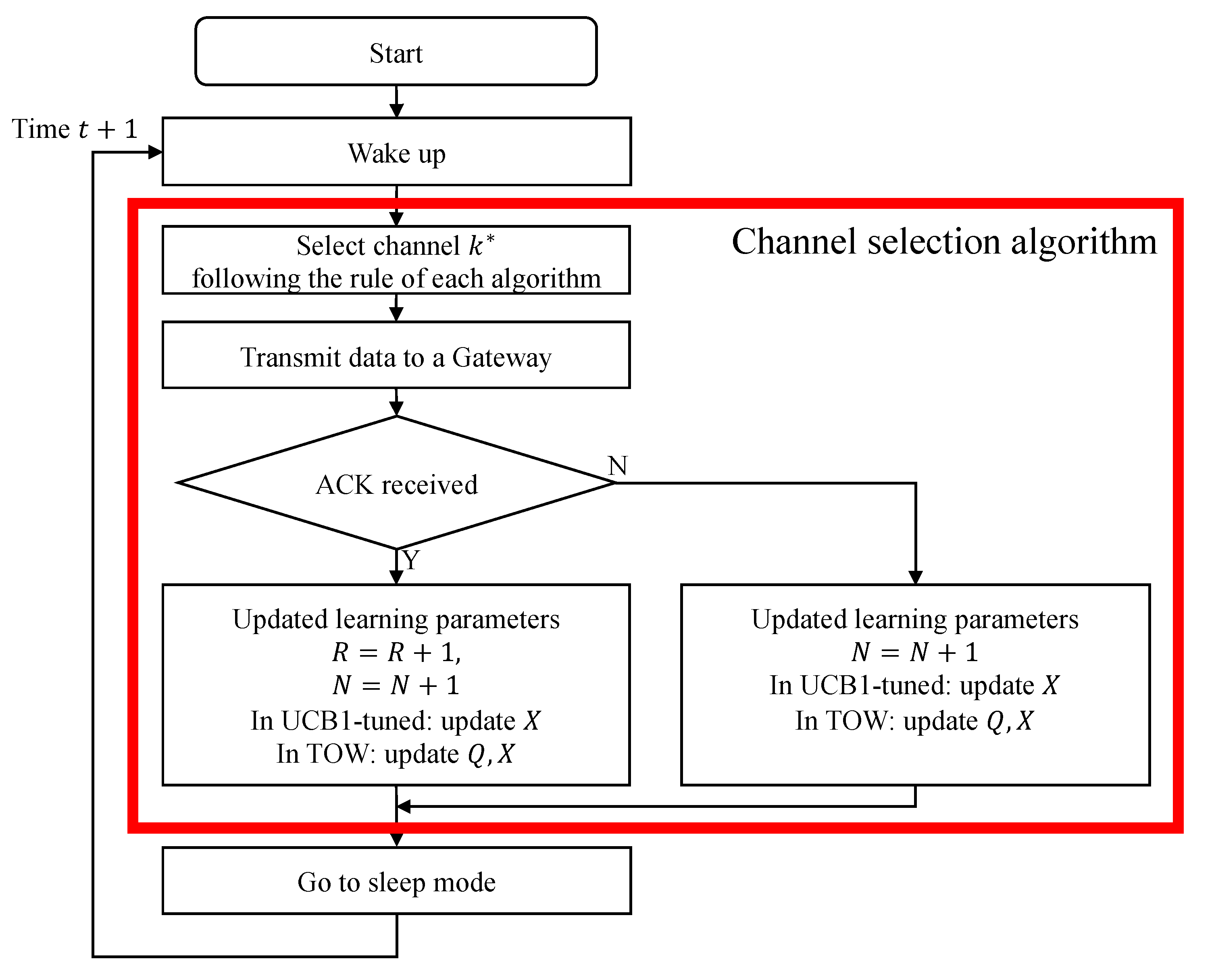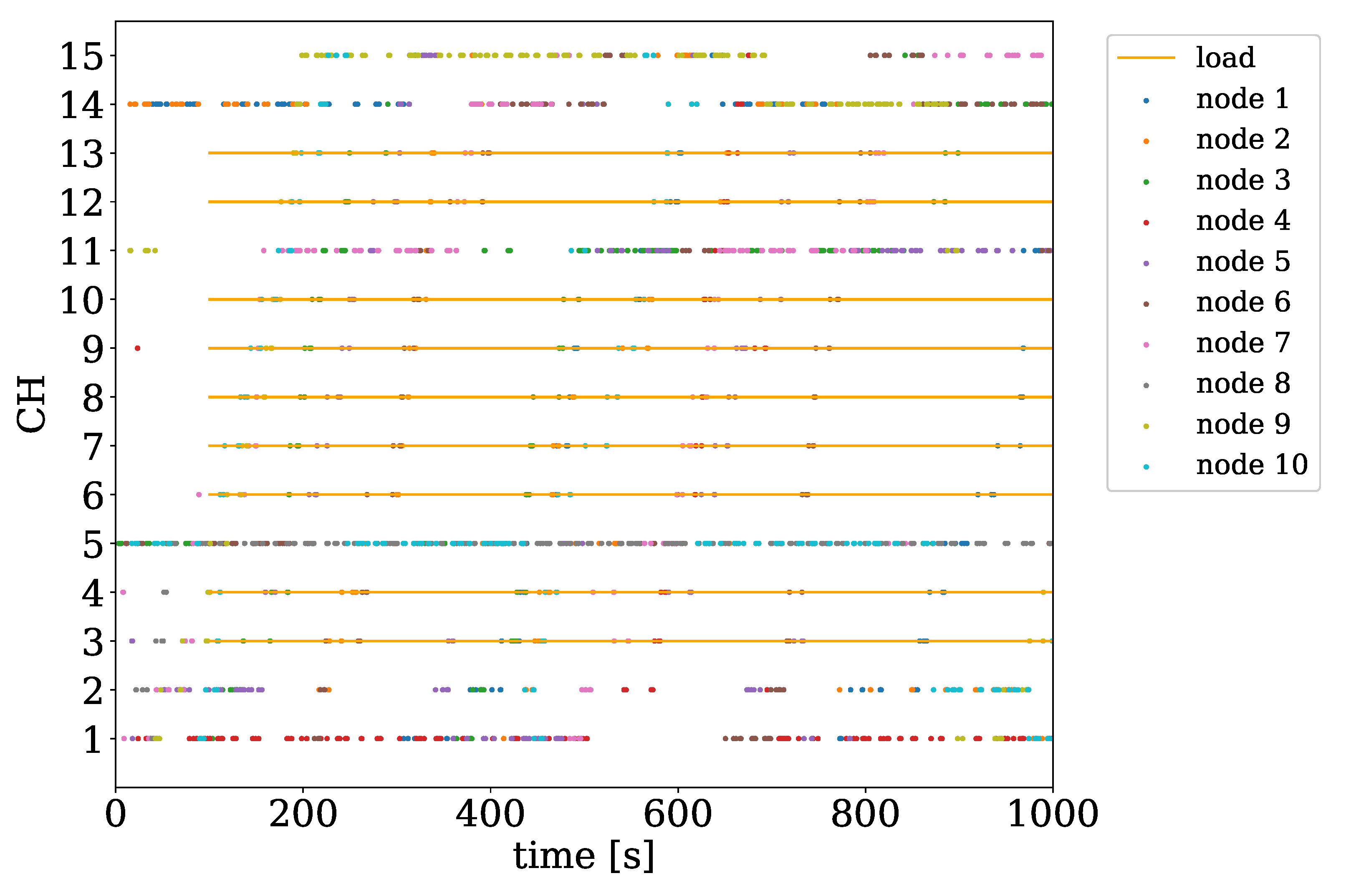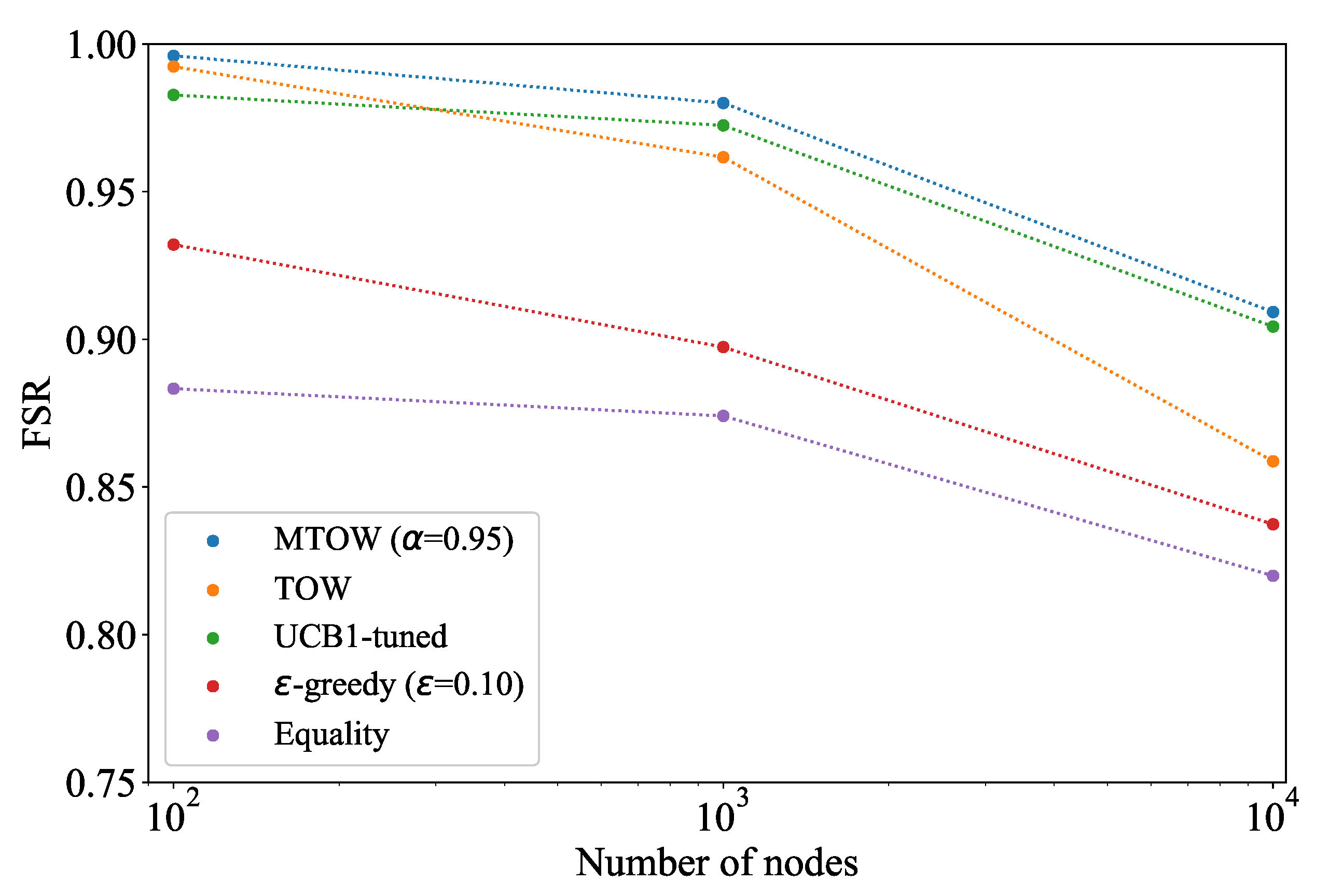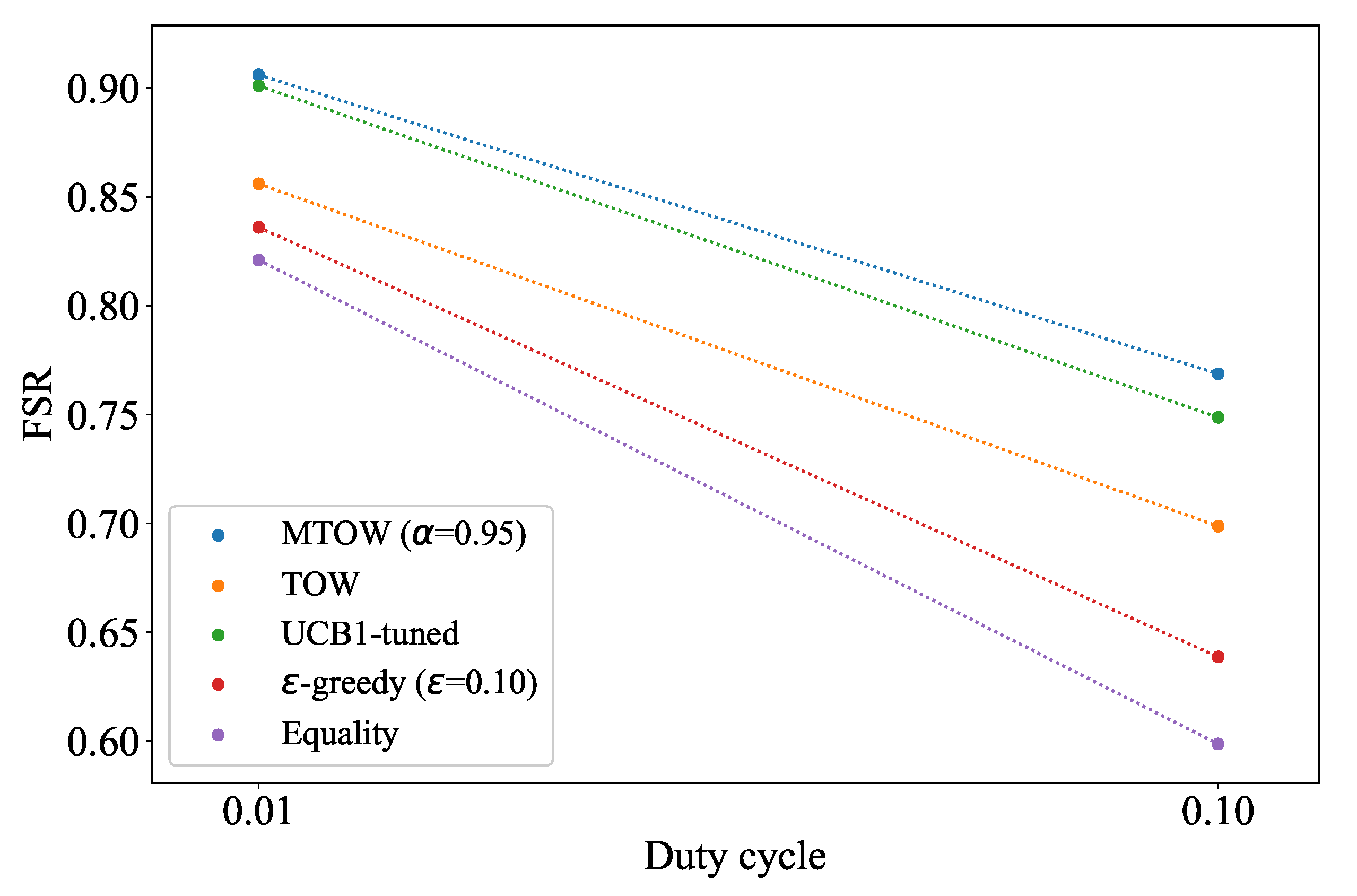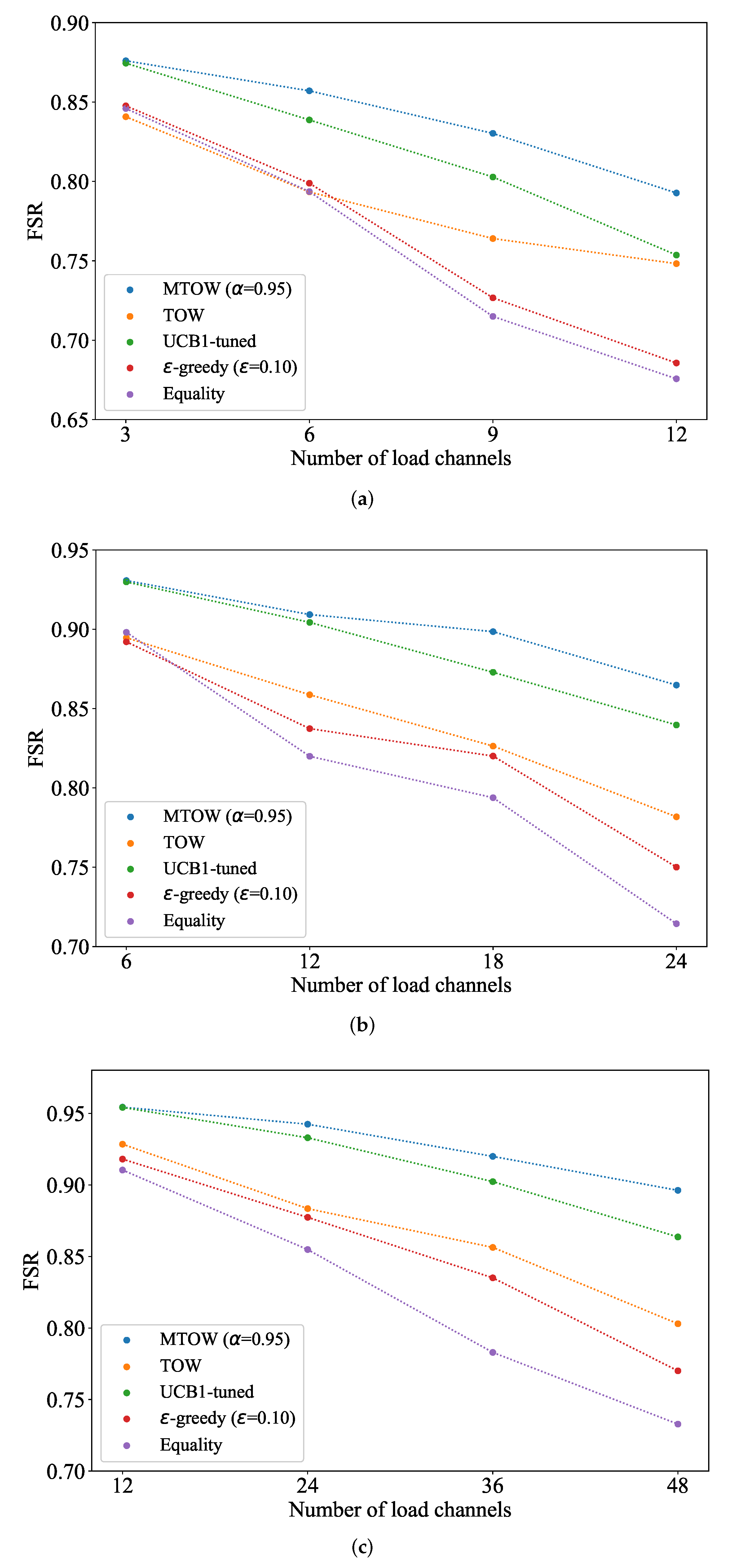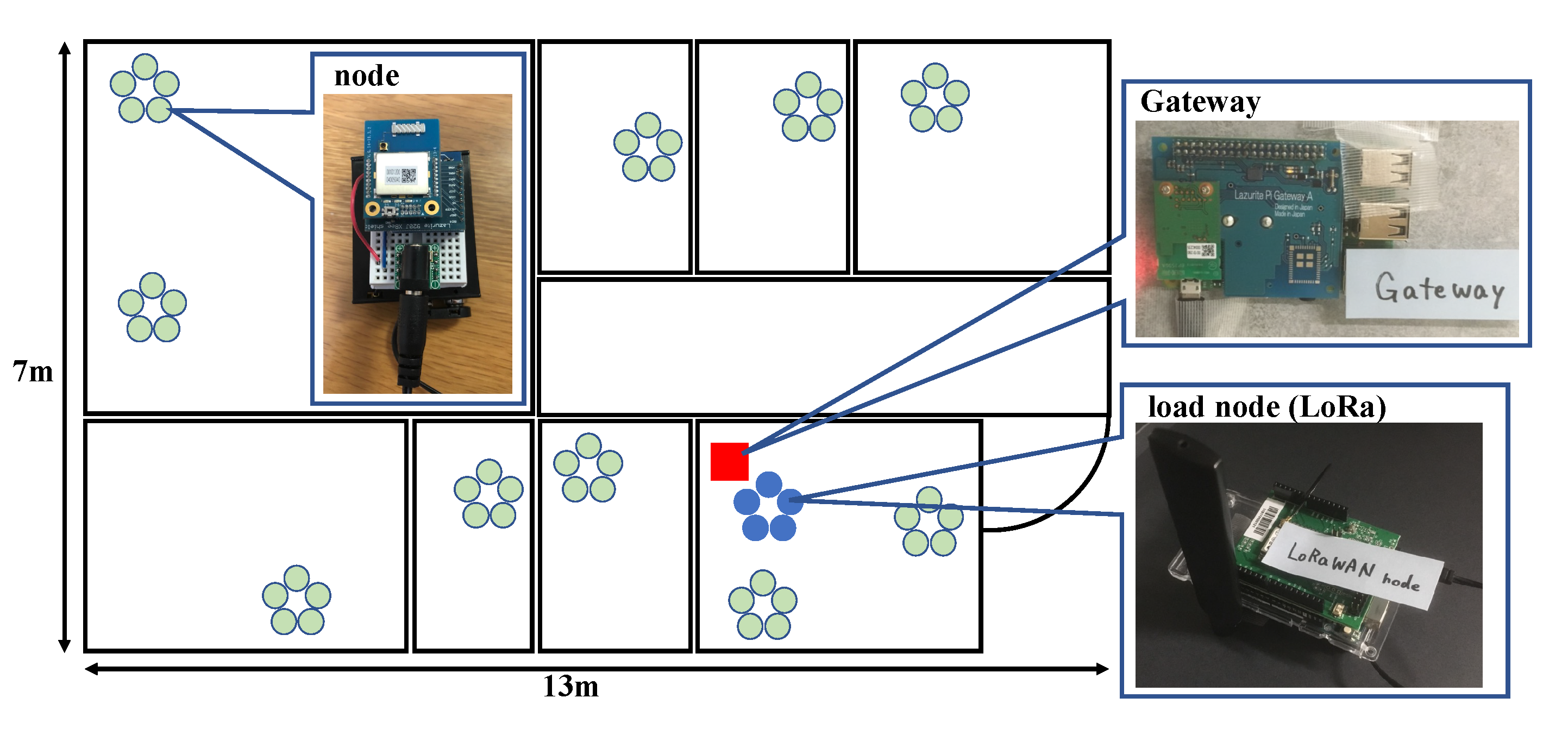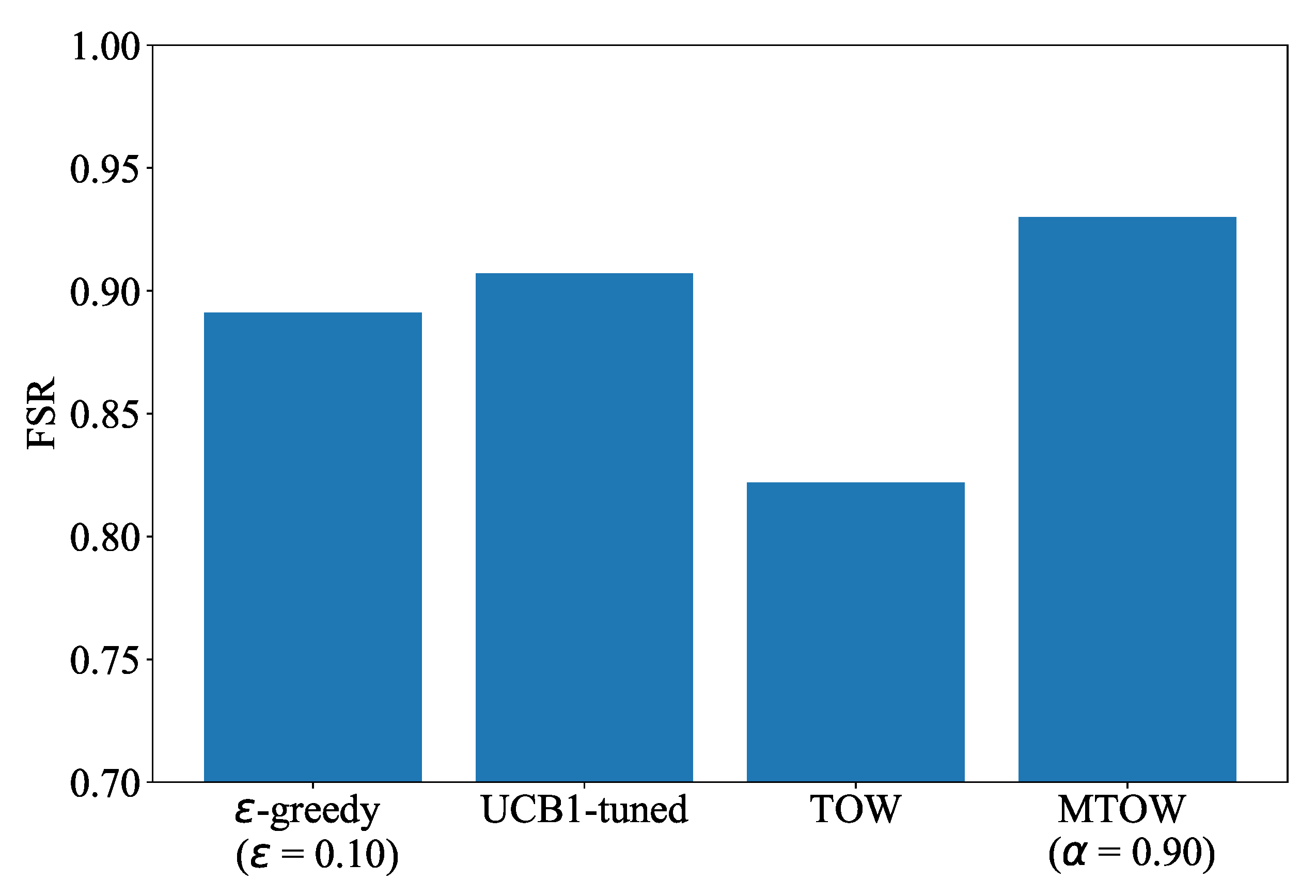1. Introduction
In recent years, the number of Internet-of-Things (IoT) devices has increased. The International Data Corporation (IDC) predicts that more than 40 billion IoT devices will generate 79 zettabytes (ZB;
bytes) by 2025 [
1]. One of the goals of Beyond 5G is to support massive machine-type communications (mMTC). 6G-IoT aims to support the transmission of 10 million connected devices per square kilometer [
2]. Various companies and alliances have developed unique low-power wide-area (LPWA) systems and have offered their own devices or network services. The wireless intelligent utility network (Wi-SUN) spreads across more than 40 countries, Sigfox in more than 70 countries, and LoRa in more than 160 countries, and they have been leading the IoT world [
3]. Network congestion would become unavoidable in a “massive” IoT environment. Each country has regulations on available frequencies band and communication channels for IoT devices. For example, the 915 MHz band is assigned in the US, the 433 MHz and 868 MHz band in the EU, and the 920 MHz band in Japan. In addition, the duty ratio, which indicates the communication frequency, is set to 1% or less or 10% or less. Efficient use of frequency resources is essential to ease congestion while complying with regulations. This fact has motivated many researchers to discuss dynamic spectrum access, where IoT devices can access channels dynamically to improve spectrum efficiency.
There are mainly two categories of resource allocation methods: centralized ones and decentralized ones. Regarding the centralized methods, references [
4] propose time-slotted channel hopping (TSCH) based channel allocation methods that have been adopted in the IEEE 802.15.4e standard [
5] to improve the IoT network performance. Reference [
6] proposes a resource allocation method based on deep Q learning performed at the gateway (GW) side. Although the centralized methods can adequately manage the operation of end nodes, increasing the number of nodes brings the burden on the controlling server. In addition, synchronization and constant connection between GW and IoT devices are required, resulting in high power consumption of the end device. Therefore, the centralized methods are unsuitable for avoiding collisions in massive IoT networks.
The IoT device decides the access channels in the autonomous decentralized resource allocation method. Reference [
7] proposed a decentralized channel assignment method for cognitive radio networks. In [
8], a reinforcement learning method was adopted to dynamically select channels in a complicated communication environment. In [
9], a deep learning-based method was proposed to determine the transmission schedule and power. References [
10,
11] treated channel access by a single user as a multi-armed bandit (MAB) problem [
12]. Reference [
10] proposed a channel selection protocol based on optimization and reference [
11] analyzed the average communication performance of competitive users. Reference [
13] formulated the channel access problem as multi-player MAB (MP-MAB) problems. In [
14], the channel assignment problem is also formulated as an MP-MAB problem. The proposed MAB-based channel assignment method in this work is implemented on a single-board computer supported by IEEE 802.15.4g/4e communication. The performance is evaluated using 30 IoT devices, verifying that the MAB methods are efficient for the channel assignment in dynamic IoT systems. However, a massive heterogeneous scenario is not well considered. In [
15], a distributed learning technique based on bandit algorithms is proposed for LoRa devices to select their access selection. In [
16], a distributed channel selection method based on TOW dynamics is proposed for fully decentralized networks. Both reference [
15] and reference [
16] implement and evaluate their proposed methods on the practical IoT devices.
Contributions of This Paper
This paper focuses on lightweight learning algorithms that can be implemented on IoT devices. MAB algorithms are the simplest reinforcement learning method. In the MAB algorithm-based channel selection methods, the channel can be selected only based on ACK information. The communication performance may be improved by using some other information besides ACK information. However, it takes time to obtain the information, which may increase energy consumption. Since the state information other than ACK information is necessary for the Q learning method or deep reinforcement learning method in related work, which may reduce energy efficiency. Hence, compared to the other reinforcement learning method, the MAB methods considered in this paper may achieve higher energy efficiency and are more suitable for battery powered IoT devices. On the other hand, although there are several works on MAB-based channel selection that are implemented on IoT devices, channel selection under massive heterogeneous IoT networks is not considered in the related work.
To support substantial IoT devices in the next-generation communication systems, the effectiveness of the MAB-based channel assignment methods in massive heterogeneous IoT networks is verified in this paper. Specifically, the effectiveness of the MAB-based channel assignment method in a massive heterogeneous IoT network consisting of 10,000 devices is firstly evaluated by simulations. Subsequently, the performance in frame success rate (FSR) is evaluated using the 50 Wi-SUN IoT devices with IEEE 802.15.4g/4e protocol in the IoT networks coexisting with the LoRa devices. The contributions of this paper can be summarized as follows.
The channel assignment problem is formulated as a MAB problem and apply MAB algorithms to solve the formulated problem in massive heterogeneous IoT networks.
The effectiveness of the MAB-based channel assignment methods in FSR is evaluated and verified under a massive IoT network with 10,000 IoT devices.
The MAB-based channel assignment methods is implemented on actual Wi-SUN IoT devices and evaluates the performance in FSR under the IoT heterogeneous network coexisting with LoRa devices.
The remainder of this paper is organized as follows.
Section 2 summarizes the frequency standards of major countries and LPWA networks that are widely deployed worldwide.
Section 3 describes the system model and problem formulation.
Section 4 presents the MAB-based channel assignment methods.
Section 5 evaluates the performance in FSR of the MAB-based channel assignment methods through simulations, assuming a massive heterogeneous IoT networks with 10,000 IoT devices.
Section 6 describes the experiments conducted in a real IoT network where Wi-SUN IoT devices coexist with LoRa devices. Finally,
Section 7 provides the concluding statement.
2. Low-Power Wide-Area Networks
Applications such as smart cities and smart meters need to cover a large area with low power consumption communication to realize long-term operation without maintenance. Traditional wireless local area networks (WLANs) such as Wi-Fi and cellular networks are not suitable to meet this requirement. To meet the requirement, various standards for IoT networks have already been developed over the last decade, such as LoRa, Sigfox, and Wi-SUN. This section introduces these major standards of the IoT networks.
LoRa is a unique chirp spread spectrum modulation technique optimized for long-range low-power communications. The data rate of the LoRa devices mainly depends on the used bandwidth, spreading factor (SF), and forward error correction (FEC) rate. The bandwidth is typically set to 125 kHz or 250 kHz for the uplink and 500 kHz for the downlink. The SF values can range from 7 to 12, and the FEC rate can vary from 4/8 to 4/5. Setting a larger SF value can improve receiver sensitivity and wider coverage; however, the data rate is consequently reduced. LoRaWAN is the most widely used protocol stack for LoRa networks and has 240 million devices in 170 countries [
17], End LoRa devices connect to one or more gateways through a single hop. A LoRa gateway can process up to nine channels in parallel by combining different sub-bands, and SF [
18]. LoRa has a capture effect that makes it possible to recover a LoRa signal, provided that the desired signal is at least one dB above the interference level.
Sigfox is a standard originating in France and currently has 75 regions and countries with more than 19 million devices [
19]. Sigfox utilizes unlicensed ISM bands and differential-BPSK (D-BPSK) modulation. The message is sent with a fixed bandwidth of 100 Hz and a speed of 100 bps for the uplink, and 200 Hz and 600 bps for the downlink, respectively. This modulation technique belongs to the ultra-narrow band (UNB) modulation. The advantages of using D-BPSK modulation are its high efficiency in the spectrum medium access and ease of implementation. A low bit-rate enables the use of low-cost transceiver components. Sigfox transmits data by changing the frequency three times for each data to ensure data transmission. Sigfox technology has a duty cycle whose restrictions vary within the transmission band from 0.1% to 10%, depending on regional regulations [
20].
Wi-SUN is a standard based on IEEE 802.15.4g/4e and deployed in 46 countries, and has more than 100 million devices [
21]. IEEE 802.15.4g is an amendment to the IEEE 802.15.4 standard, focusing on SUN communications that play an essential role in the smart grid [
22]. The standard specifies several modes that operate in different bands, including the sub-GHz industrial science and medical (ISM) bands. Multirate frequency-shift keying (MR-FSK) with 2-FSK or 4-FSK is the main modulation technique used in Wi-SUN devices. The data rate varies from 2.4 to 200 kbps, depending on the region and frequency band. The mandatory configuration for all regions is 2-FSK, which operates at 50 kbps, implying a channel spacing of 200 kHz. More than 50 million smart meters in Japan that can collect electricity consumption data using this standard have already been deployed. Their number is expected to increase in the future.
The IoT standards described above coexist in the same frequency band called the ISM band [
23]. Thus, an increase in the number of IoT devices leads to a significant decrease in network performance because devices following each standard may affect other devices, which will bring collisions to the massive heterogeneous IoT networks [
24]. By the MAB-based channel assignment methods that will be present in this paper, approximately 10,000 IoT devices can be accommodated in such coexistence IoT networks.
3. System Model
This section describes the system model and problem formulation.
Figure 1 illustrates an IoT network environment where one or more gateways with multiple asynchronous IoT devices are distributed in each of the
m IoT networks. In each network, the IoT devices send data to the gateway according to their standards regarding the network configuration, frequency channel to be used, transmission timing, and so on. Each IoT network could not know the standards and the locations of the IoT devices and gateways of the other IoT networks. Therefore, it is difficult to avoid collisions between heterogeneous IoT networks.
Figure 2 shows the channel selection problem of one IoT network in such heterogeneous IoT networks. In the network,
K channels are available. A gateway and
M IoT devices are associated with the star topology. IoT device sends data to the gateway, and when the gateway receives the data properly, the IoT device will receive an acknowledgment (ACK). This paper defines communication as success when the IoT device receives ACK information. Communication is defined as failure otherwise. If the communication fails, NACK information will be obtained on the IoT device side. For example, node 1 sends data to the gateway using channel 1; communication is successful since no other IoT device is accessing that channel. Hence, an ACK can be received from the gateway. Meanwhile, node two and node
transmit data using channel three simultaneously. The transmissions of node two and node
are failures because of the collision between them. In addition, node M transmits using channel k also fails because the node interferes with other IoT networks. In summary, the transmission will be assumed as a failure if two or more than two IoT devices access the same channel simultaneously, no matter which IoT network the devices belong to.
Figure 3 shows the occupied state of the channel in the time domain. If multiple nodes send data using the same channel simultaneously, a collision will occur, and the communications are assumed to fail. Assume that an IoT battery-powered node will be driven for an extended period without charging. All nodes repeat the wake-up and sleep modes. Assume the sleep time for each IoT device is
t. After
t. time sleep, a node sends data to the gateway by utilizing the selected channel
k based on the MAB methods from the available
K channels. It does not matter if the node performs carrier sensing before transmission as long as it complies with the communication standard. The contents of the data and data size depend on the requirement of IoT devices. A node will be in sleep mode after sending and saving the result of receiving the ACK/NACK information.
5. Performance Evaluation
In this section, the performance of the MAB-based channel selection methods is evaluated by simulation. In the simulation, there are two kinds of massive IoT networks where ALOHA communication without channel sensing is adapted. IoT devices in one network transmit data using the channel selected by the MAB-based methods. IoT devices in the other network transmit data using the allocated fixed channel following a two-state Markov model [
34]. The two states are ON state and OFF state. During the ON state, IoT devices operate regularly, including wake-up and sleep modes. During the wake-up mode, the IoT device transmits data using the allocated fix channel. During the sleep mode and OFF state, IoT devices keep silent without transmitting data. The state transition probability of the two-state Markov model can be expressed as:
where
is a parameter that indicates the ease of transition of the state transitions in channel
k and its range is from −1 to +1. This formulation means that the network continues the past state (i.e., ON-ON or OFF-OFF) with a probability of
and transitions from the past state to a different state (i.e., ON-OFF or OFF-ON) with a probability of
. The transmission is a failure if two or more IoT devices simultaneously access the same channel. This paper verifies the effectiveness of applying the MAB algorithm such as
-greedy, UCB1-tuned, and basic TOW and MTOW to the channel selection problem in a massive heterogeneous IoT network and evaluates the network performance in terms of FSR. The common simulation settings are summarized in
Table 1. Note that the value of
is set to 0.1 in the simulation.
Figure 6 shows an example of channel selection based on the TOW method. In the simulation, the numbers of IoT nodes and channels are set to 10 and 15, respectively. Among the 15 channels, 12 channels are loaded by the other IoT network. The orange line in
Figure 6 indicates the loaded channel and the loaded time by the IoT devices of the other IoT network. The channel access situation of the 10 IoT devices in the IoT network accessing channels based on TOW algorithms are shown at different points. Simulation results show that the IoT devices can avoid accessing the channels loaded by other IoT networks. The reason is that IoT devices can select the channel with the highest probability based on the TOW method. The communication fails when IoT device selects the channel that are loaded by other IoT networks, which reduces the probability of the selected channel. By iterative selection and the update of the probability parameter corresponding to each channel, IoT devices can select the channels without load.
Figure 7 illustrates the relation between the FSR and the number of IoT nodes. In this simulation, the number of IoT devices varies from
to
. The number of channels is set to 20. The parameter related to the state transition probability of the IoT devices in the network where IoT devices transmit data using the allocated fixed channels
is set as 0.8. The duty ratio is set to 0.5. From the simulation results, it can be observed that as the number of nodes increases, FSR decreases. The reason is that with the increase of the IoT devices, the collisions among IoT devices in the same IoT network increase. Even though the FSR decreases with the increase of the number of IoT devices, the FSR is higher than 90% for the TOW/MTOW channel selection method when the number of IoT devices is
. The reason is that the TOW/MTOW-based channel selection method can select the channel with highest available probability. Hence, the TOW/MTOW is effective for the massive heterogeneous IoT networks.
Figure 8 illustrates the relation between the FSR and the duty cycle of the IoT nodes. In this simulation, the numbers of IoT nodes and channels are set to 10,000 and 30. Among the 30 available channels, 12 channels may be loaded by the IoT devices in the other network.
and the duty ratio are set to 0.8 and 0.5, respectively. The simulation results show that the FSR decreases with the increase of the duty ratio. The reason is that the transmission interval becomes shorter with the increased duty ratio, which will increase the collision probability among IoT devices. Moreover, the MTOW can obtain the highest FSR. The reason is that channel selection-based MTOW can select the channel with the highest available probability. In addition, the MTOW method is more adaptable to dynamic environments due to the introduction of the forgetting parameter, which is introduced to reduce the influence of past experiences.
Figure 9 illustrates the relation between the FSR and the number of available channels. In this simulation, the number of IoT nodes is set to 10,000. The number of channels that may be loaded by the IoT devices in the other IoT network is set to 12. The transition parameter
and the duty ratio are set to 0.8 and 0.5. Simulation results show that the FSR increases with the number of available channels. The reason is that with the increase of the number of available channels, the average number of IoT nodes assigned to each channel is decreased, which reduces the probability of collisions. In addition, the MTOW can get the highest FSR no matter how many available channels there are for the IoT network. The reason is that the introduction of the forgetting parameter can make the method more adaptable to a dynamic environment.
Figure 10 illustrates the relation between the FSR and the numbers of available and loaded channels.
Figure 10a–c show the FSR when the number of available channels are set to 15, 20, and 60, respectively. The number of channels that may be loaded varies from 20% to 80% of the available channels. The numbers of duty ratio and IoT nodes are set to 0.5 and 10,000, respectively. The transition parameter
is set to 0.8. Simulation results show that the FSR decreases with the increases of the loaded channels. The reason is that collisions among different IoT networks increase when the number of load channels becomes larger. In addition, MTOW can get much better FSR than the other methods when the number of loaded channels increases, which shows that MTOW may be more effective for heterogeneous IoT networks with a larger number of IoT devices. Hence, MTOW could be applied for the heterogeneous IoT network with a higher congestion degree, while UCB1-tuned/MTOW could be used for the heterogeneous IoT network with a lower congestion degree.
The experimental results described above show that MTOW can achieve the highest-performance in FSR compared to the other three methods. These results have also been evaluated in [
16]. Moreover, the theoretical analysis in [
30] also shows that regret, an indicator of how much loss was made from the appropriate choices, is smaller for the TOW-based algorithm than that for the UCB1-tuned algorithm. From the experimental results of this paper, it is clarified that MTOW-based channel selection algorithm works properly in a dynamic environment with a huge number of IoT nodes where competition caused by other coexistence IoT exists.
6. Implementation and Performance Evaluation of the Multi-Armed-Bandit-Based Channel Selection Methods on Internet of Things Devices
In this section, the performance of the channel selection-based MAB algorithms simulated in
Section 5 is implemented and evaluated using the actual IoT devices. Wi-SUN IoT devices and LoRa are used as the evaluation IoT network and the interference IoT network, respectively. For the Wi-SUN IoT devices, Lazurite 920J, which supports IEEE 802.15.4g/4e standard and can communicate using the 920 MHz band, is used.
Table 2 lists the specification of the Lazurite 920J.
Figure 11 shows the settings of the IoT devices in the experiment. The heterogeneous IoT network is constructed in a 13 m × 7 m square area. A Wi-SUN IoT network consists of 50 Wi-SUN devices (i.e., Lazurite) and a gateway is deployed in this area. Meanwhile, a LoRa network composed of 5 LoRa devices is also deployed in the area. Wi-SUN devices select the access channels based on the MAB algorithms. A Raspberry Pi controls each Wi-SUN device. The MAB algorithms are implemented on the Raspberry Pi to calculate the access channel and control the Wi-SUN device to transmit data using the selected channel. LoRa devices transmit data using channel 34 every 20 min. The transmission interval for the LoRa device is 10 s.
Table 3 summarizes the experimental settings.
Figure 12 shows the experimental results in FSR of the MAB-based channel selection methods, i.e.,
-greedy based, UCB-1tuned based, TOW-based, and MTOW-based channel selection method. Wi-SUN devices select their access channel among three channels, i.e., CH34, CH37, and CH40, using the MAB-based channel selection methods.
Figure 12 shows that the MTOW can achieve the highest FSR. In addition, the fairness index (FI) values for
-greedy based, UCB-1tuned based, TOW-based, and MTOW-based channel selection method are 0.997, 0.995, 0.974, and 0.998, respectively. Hence, The MTOW-based channel selection method is superior to the other MAB-based channel selection methods in FI and FSR under both simulation and implementation. The experimental results also verify the effectiveness of the MTOW algorithm in dynamic environments, which introduces the forgetting parameter to adapt to the dynamic environment.
7. Conclusions
In this paper, the effectiveness of the MAB-based autonomous decentralized channel selection methods for massive heterogeneous IoT networks is evaluated. Specifically, the FSR can reach 95% when the numbers of channels and IoT devices are 60 and 10,000, respectively, while 12% channels are suffering traffic load by other kinds of IoT devices. In addition, the performance in terms of FSR improves by 20% compared to the equality channel allocation. In addition, the MAB algorithm, termed MTOW, can achieve the highest FSR in any setting. Moreover, the performance of the MAB-based channel selection methods is implemented and evaluated on IoT devices. Experimental results show that the MTOW-based channel selection method can achieve the highest FSR and FI, i.e., around 0.95, and 0.998, respectively. In summary, the MTOW-based channel selection method can get high FSR either in simulation or experiments. As described above, due to the high FSR and FI, and easy application concerning the practical IoT devices, the MTOW-based channel selection method may become an efficient technique to support massive IoT applications, such as smart city, personal IoT, Smart grid, industrial assets monitoring, agriculture, and many other applications [
35] in the next generation of wireless communication networks. In our further work, we will investigate the impact of the parameters in the MAB algorithm on the performance for massive heterogeneous IoT networks. For instance, the
value in
-greedy algorithm, the
in MTOW algorithm, and so on. Moreover, the time consumption of the evaluated algorithms in this paper will be experimentally analyzed later.

